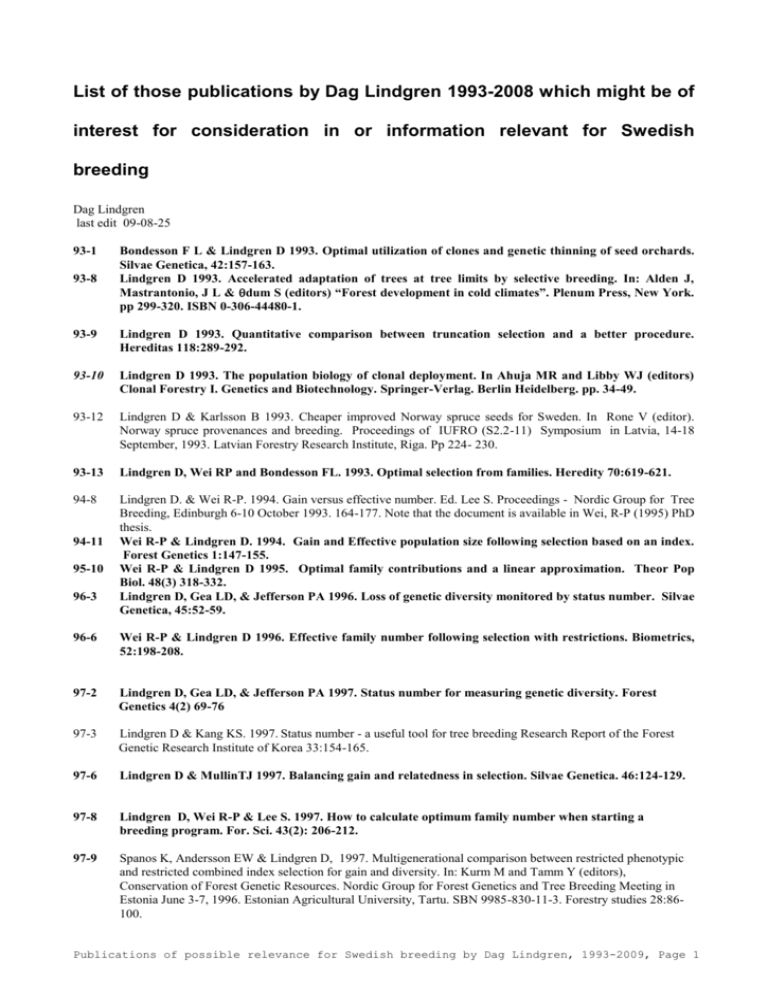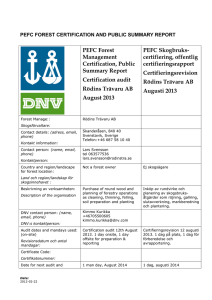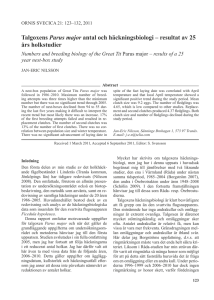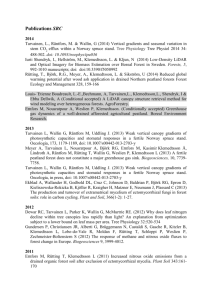List of those publications by Dag Lindgren 1993
advertisement

List of those publications by Dag Lindgren 1993-2008 which might be of interest for consideration in or information relevant for Swedish breeding Dag Lindgren last edit 09-08-25 93-1 93-8 Bondesson F L & Lindgren D 1993. Optimal utilization of clones and genetic thinning of seed orchards. Silvae Genetica, 42:157-163. Lindgren D 1993. Accelerated adaptation of trees at tree limits by selective breeding. In: Alden J, Mastrantonio, J L & dum S (editors) “Forest development in cold climates”. Plenum Press, New York. pp 299-320. ISBN 0-306-44480-1. 93-9 Lindgren D 1993. Quantitative comparison between truncation selection and a better procedure. Hereditas 118:289-292. 93-10 Lindgren D 1993. The population biology of clonal deployment. In Ahuja MR and Libby WJ (editors) Clonal Forestry I. Genetics and Biotechnology. Springer-Verlag. Berlin Heidelberg. pp. 34-49. 93-12 Lindgren D & Karlsson B 1993. Cheaper improved Norway spruce seeds for Sweden. In Rone V (editor). Norway spruce provenances and breeding. Proceedings of IUFRO (S2.2-11) Symposium in Latvia, 14-18 September, 1993. Latvian Forestry Research Institute, Riga. Pp 224- 230. 93-13 Lindgren D, Wei RP and Bondesson FL. 1993. Optimal selection from families. Heredity 70:619-621. 94-8 Lindgren D. & Wei R-P. 1994. Gain versus effective number. Ed. Lee S. Proceedings - Nordic Group for Tree Breeding, Edinburgh 6-10 October 1993. 164-177. Note that the document is available in Wei, R-P (1995) PhD thesis. Wei R-P & Lindgren D. 1994. Gain and Effective population size following selection based on an index. Forest Genetics 1:147-155. Wei R-P & Lindgren D 1995. Optimal family contributions and a linear approximation. Theor Pop Biol. 48(3) 318-332. Lindgren D, Gea LD, & Jefferson PA 1996. Loss of genetic diversity monitored by status number. Silvae Genetica, 45:52-59. 94-11 95-10 96-3 96-6 Wei R-P & Lindgren D 1996. Effective family number following selection with restrictions. Biometrics, 52:198-208. 97-2 Lindgren D, Gea LD, & Jefferson PA 1997. Status number for measuring genetic diversity. Forest Genetics 4(2) 69-76 97-3 Lindgren D & Kang KS. 1997. Status number - a useful tool for tree breeding Research Report of the Forest Genetic Research Institute of Korea 33:154-165. 97-6 Lindgren D & MullinTJ 1997. Balancing gain and relatedness in selection. Silvae Genetica. 46:124-129. 97-8 Lindgren D, Wei R-P & Lee S. 1997. How to calculate optimum family number when starting a breeding program. For. Sci. 43(2): 206-212. 97-9 Spanos K, Andersson EW & Lindgren D, 1997. Multigenerational comparison between restricted phenotypic and restricted combined index selection for gain and diversity. In: Kurm M and Tamm Y (editors), Conservation of Forest Genetic Resources. Nordic Group for Forest Genetics and Tree Breeding Meeting in Estonia June 3-7, 1996. Estonian Agricultural University, Tartu. SBN 9985-830-11-3. Forestry studies 28:86100. Publications of possible relevance for Swedish breeding by Dag Lindgren, 1993-2009, Page 1 97-10 Wei R-P, Lindgren D & Yeh FC. 1997. Expected gain and status number following restricted individual and combined- index selection. Genome, 40:1-8. 97-11 Zheng YQ, Lindgren D, Rosvall O & Westin J. 1997. Combining genetic gain and diversity by considering average coancestry in clonal selection of Norway spruce. Theor Appl Genet 95:1312-1319. 98-1 Andersson EW, Lindgren D, Spanos KA, & MullinTJ 1998. Genetic diversity after one round of selection. Forest Tree Improvement 26:47-55. 98-2 Andersson EW, Spanos KA, MullinTJ & Lindgren D 1998, Phenotypic selection can be better than selection for breeding value. Scand. J. For. Res. 13:7-11. 98-3 Andersson EW, Spanos KA, MullinTJ & Lindgren D Phenotypic selection compared to restricted combined index selection for many generations. Silva Fennica, 32:111-120. 98-6 Gea LD, Lindgren D, Shelbourne CJA & Mullin TJ 1997. Complementing inbreeding coefficient information with status number: implications for structuring breeding populations. New Zealand Journal of Forestry Science 27(3):255-271 (as it become known too late, it still keeps the 98 number) 98-9 Lindgren D. 1998. Balansen mellan produktion och genetisk mångfald. (In Swedish) Skogsfakta, 7 1998. 98-10 Lindgren D & MullinTJ 1998. Relatedness and status number in seed orchard crops. Canadian Journal of Forest Research, 28:276-283. 98-13 Rosvall, O, Lindgren, D and Mullin, T.J.. 1998. Sustainability, robustness and efficiency of a multigeneration breeding strategy based on within-family clonal selection. Silvae Genetica, 47:307-321. 98-14 Ruotsalainen S & Lindgren D 1998. Predicting genetic gain of backward and forward selection in forest tree breeding Silvae Genetica. 47: 42-50. 98-15 Zheng YQ, Andersson EW & Lindgren D 1998. A model for infusion of unrelated material into a breeding population. Silvae Genetica: 47:94-101 99-8 Rosvall O, Lindgren D & Ruotsalainen S 1999. Högre vinst utan diversitetsförlust. (In Swedish). Föreningen skogsträdsförädling Årsbok 1998, pp 9-16. 00-5 Lindgren D & Ying CC 2000. A model integrating seed source adaptation and seed use. New Forest 20: (1) 87-104 00-6 Olsson T. Lindgren D. & Ericsson T. 2000. Group merit selection and restricted selection among full-sib progenies of Scots pine. Forest Genetics 7(2):137-144. 00-8 Ruotsalainen S & Lindgren D 2000 Stratified sublining: a new option for structuring breeding populations Canadian Journal of Forest Research. 30: (4) 596-604 01-12 Ruotsalainen S & Lindgren D 2001 Number of founders for a breeding population using variable parental contribution. Forest Genetics 8:59-68. 01-14 Wei, R.-P. & Lindgren, D 2001. Optimum breeding generation interval considering build-up of relatedness. Canadian Journal of Forest Research 31:722-729 02-01 Danusevičius D & Lindgren D 2002. Efficiency of Selection Based on Phenotype, Clone and Progeny Testing in Long-term Breeding. Silvae Genetica 51:19-26. Publications of possible relevance for Swedish breeding by Dag Lindgren, 1993-2009, Page 2 02-04 Danusevičius D & Lindgren D 2002. Two-stage selection strategies in tree breeding considering gain, diversity, time and cost. Forest Genetics. 9:145-157. 02-06 Kang, K.S., Lai, H.-L. & Lindgren, D. 2002. Using single family in reforestation: gene diversity concerns. Silvae Genetica 51: 65-72. 03-09 Rosvall O, Mullin TJ & Lindgren D 2003. Controlling parent contributions during positive assortative mating and selection increases gain in long-term forest tree breeding. Forest Genetics 10: 35-54. 04-02 Danusevičius D & Lindgren D 2004. Progeny testing preceded by phenotypic pre-selection - timing considerations. Silvae Genetica 53:20-26. 04-07 Lstibùrek M, Mullin T, Lindgren D, Rosvall O. 2004. Open-nucleus breeding strategies compared to population-wide positive assortative mating. I. Equal distribution of testing effort. TAG 109: 11961203. 04-08 Lstibùrek M, Mullin T, Lindgren D, Rosvall O. 2004. Open-nucleus breeding strategies compared to population-wide positive assortative mating. II. Unequal distribution of testing effort. TAG 109:11691177. 05-02 Danusevičius D & Lindgren D 2005. Optimisation of breeding population size for long-term breeding. Scandinavian Journal of Forest Research, 20:18-25. 05-03 Fedorkov A, Lindgren D, and David A. 2005. Genetic gain and gene diversity following thinning in a half-sib plantation. Silvae Genetica 54:185-189. 05-07 Lindgren D 2005. Unbalances in tree breeding. In Fedorkov A (editor) Status, monitoring and targets for breeding programs. Proceedings of the meeting of Nordic forest tree breeders and forest geneticists, Syktyvkar 2005, ISBN 5-89606-249-4: 45-56. 05-08 Lindgren D and Prescher F 2005. Optimal clone number for seed orchards with tested clones. Silvae Genetica 54: 80-92. 05-10 Mullin TJ Lstiburek M Rosvall O & Lindgren D 2005. Korsa utvalda träd i rangordning och låt dessutom de bästa få fler avkommor. Föreningen Skogsträdsförädling Årsbok 2004, pp 8-18. (In Swedish). Ruotsalainen, S. 2002. Managing breeding stock in the initiation of a long-term tree breeding program. Finnish Forest Research Institute, Research Papers 875., 95 + 61 p. Danusevičius D & Lindgren D. 2006. Optimization of long term breeding strategies for cyclic within family selection IUFRO 2.04.02 Breeding theory and progeny testing Newsletters 1:26. Li H & Lindgren D. 2006. Comparison of phenotype and combined index selection at optimal breeding population size considering gain and gene diversity. Silvae Genetica:13-19. Wei R-P & Lindgren D 2006. Stepwise Penalty Index Selection from populations with a hierarchical study. Silvae Genetica 55:62-70. Lindgren, D & Wei RP 2007. Low-input tree breeding strategies. In Proceedings of the IUFRO Division 2 Joint Conference: Low Input Breeding and Conservation of Forest Genetic Resources: Antalya, Turkey, 9-13 October 2006. Edited by Fikret Isik. p 124-138. Danusevicius D & Lindgren D 2008 "Strategies for optimal deployment of related clones into seed orchards" Silvae Genetica 57:119-127 Publications of possible relevance for Swedish breeding by Dag Lindgren, 1993-2009, Page 3 Lindgren D, Danusevičius D & Rosvall O 2008. Balanced forest tree improvement can be enhanced by selecting among many parents but keeping balance among grandparents. Canadian Journal of Forest Research 38(11): 2797–2803. Genetic Thinning of Clonal Seed Orchards using Linear deployment may improve both gain and diversity. Forest Ecology and Management 254: 188-192. Prescher F, Lindgren D & Karlsson B 2008. Lindgren D (editor) Proceedings of a Seed Orchard Conference, Umeå, Sweden, 26-28 September 2007. ISBN:978-9185911-28-8. 256 pages. Lindgren D, Karlsson B, Andersson B & Prescher F, 2008. The Swedish seed orchard program for Scots pine and Norway spruce. In Lindgren D (editor) Proceedings of a Seed Orchard Conference, Umeå, Sweden, 26-28 September 2007. pp 142-154. El-Kassaby YA & Lindgren D 2008. Increasing the Efficiency of Breeding Without Breeding through Phenotypic Preselection in Open Pollinated Progenies. In: Byram ED (editor) Proceeding 29th STFIC/WFGA meeting in Galveston Texas June 19-22, 2007. p15-19. http://www.fsl.orst.edu/wfga/index_files/WFGA%20proceedings%202007.pdf 08-12 Lindgren D & Prescher F 2008. Bättre fröplantager för Sveriges framtid. Skogfakta 2-2008. 08-13 Moriguchi Y, Prescher F & Lindgren D 2008. Optimum lifetime for Swedish Picea abies seed orchards. New Forests 35:147-157. Lindgren D 2009. Tankar på far och morföräldrar påverkar skogsproduktionen. Södra kontakt 1:28. Lindgren D, Danusevičius D & Rosvall O 2009. Unequal deployment of clones to seed orchards by considering genetic gain, relatedness and gene diversity. Forestry 82:17-28. Lindgren D 2009. A way to utilise the advantages of clonal forestry for Norway spruce? Working Papers of the Finnish Forest Research Institute 114: 08–15. http://www.metla.fi/julkaisut/workingpapers/2009/mwp114-02.pdf In Aronen, Tuija, Nikkanen, Teijo & Tynkkynen, Tiina (eds.). 2009. Vegetative propagation of conifers for enhancing landscaping and tree breeding.. Metlan työraportteja / Working Papers of the Finnish Forest Research Institute 114. 80 s. ISBN 978-951-40-2154-1 (PDF). Saatavissa: http://www.metla.fi/julkaisut/workingpapers/2009/mwp114.htm. Lindgren D 2009 Number of pollen in polycross mixtures and mating partners for full sibs for breeding value estimation. Skogforsk., Arbetsrapport 672:1-15. In press: Kroon J, Wennström U, Prescher F, Lindgren D and Mullin TJ 2009. Cone set over time and clones in a seed orchard. Silvae Genetica: in press. Lindgren D 2009 Norway spruce breeding in Sweden is based on clone testing. Dendrobiology in press. Torimaru T, Wang X-R, Fries A, Andersson B, Lindgren D. 2009. Evaluation of pollen contamination in an advanced Scots pine seed orchard in central Sweden, Silvae Genetica in press. Publications of possible relevance for Swedish breeding by Dag Lindgren, 1993-2009, Page 4


